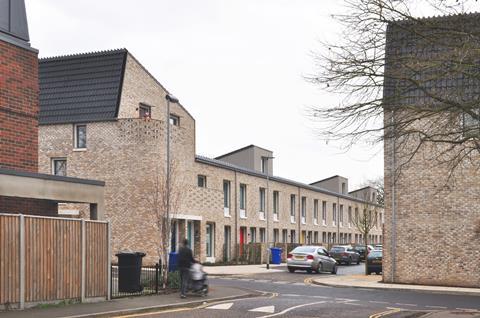Hydrogen shelved, potential mandatory EPC targets for mortgage lenders and could new homes be cut off from the gas grid? Here’s our round-up of key points - and Simon Allford’s response
We finally know what the government’s plans are for decarbonising the UK’s buildings on the path to net zero.

The heat and buildings strategy, published yesterday more than eight months after it was originally promised, comes two weeks before the UK hosts the COP26 climate conference in Glasgow, where Boris Johnson hopes to position the country as a world leader in cutting carbon emissions.
But industry groups have criticised the delayed strategy for not going far enough in providing financial incentives for people to switch to green energy to heat their homes and buildings.
The new president of the RIBA, Simon Allford, said Britain needed to demonstrate global climate leadership, but that the document did not do that.
”After over a year of waiting, this strategy does not go far enough,” he said.
”Positive references to ‘fabric first’ and ‘whole building’ approaches are overshadowed by the lack of adequate funding and the absence of vital embodied carbon targets for new buildings.
“The government has clearly stated and shown an ambition to lead, but to do so it must urgently change gear. Now.
”Moving ahead, we hope for tighter regulation, substantial and sustained funding and adaptation of tax mechanisms to encourage ‘able to pay’ homeowners to retrofit their homes”
He called on the government to define how the country will deliver ‘no- and low-regret’ actions.

With the government borrowing at least £300bn just in the first year of the pandemic, there has been speculation that the Treasury has watered down the plans to save money.
Johnson is now under pressure to prove that the UK is still on track to achieve the government’s legally binding target of reducing carbon emissions by 78% by 2035.
Here are the strategy’s key takeaways:
Homeowners will be given grants of £5,000 towards heat pumps
A core part of the strategy is the replacement of traditional gas boilers with heat pumps, energy-saving devices which absorb heat from the air or the ground.
Under the plans, homeowners will be given grants of £5,000 to install heat pumps from April next year through a £450m boiler upgrade scheme.
The funding is part of a £3.9bn package over the next four years which will also be used to decarbonise public buildings and fund heat networks.
But the heat pump grants appear to be a downgrade on proposals for starting grants of £7,000 leaked to the media in August.
With heat pumps costing at least £7,000 and gas boilers starting at £1,000, heat pumps will still be more expensive than gas boilers at current prices.
This also does not take into account installation costs for heat pumps, which can be as high as £20,000 according to Ground Source Heat Pump Association chair Laura Bishop.
With the aim of the strategy being to incentivise homeowners to switch to greener heating systems, the size of the grants risks falling short.
Hydrogen will not be used to heat buildings for at least five years
An alternative to heat pumps is hydrogen, which has lower installation costs than heat pumps.
But the strategy puts off any decision on the gas until at least 2026 while the government carries out trials to assess the technology’s feasibility.
These will include a neighbourhood trial by 2023 and a village scale trial by 2025. Plans for a hydrogen town will also be developed by 2025 that can be converted before the end of this decade.
The government said it will also look into enabling or requiring new gas boilers to be easily convertible to use hydrogen by 2026, minimising disruption and installation costs to consumers.
Government aims to insulate homes before installing new heating systems
The strategy says that improving the energy efficiency of homes through a ‘fabric-first’ approach is key in ensuring the transition to low-carbon heating is “cost-effective and resilient”.
This means that emphasis will be placed on installing insulation and other improvements to homes through retrofit programmes before installing green heating systems like heat pumps.
Types of retrofits would include draught-proofing, loft and floor insulation, heating system insulation, double and triple glazing of windows and doors and wall insulation.
Industry has called on the government to fund a national retrofit programme over the next two decades costing the public and private sector more than £500bn.
Gas boiler manufacturers could be forced to sell a required number of heat pumps
From 2024, an obligation could be imposed on manufacturers of gas boilers to sell a certain level of heat pumps in proportion to their gas boiler sales over a given period.
The proposal, which is set out in a consultation launched yesterday and closing in January, would aim to forcefully increase the numbers of heat pumps being sold on the market.
It would work alongside subsidies and regulatory policy approaches, along with grants for consumers, to bring down the cost of heat pumps.
The government said the proportion of heat pumps that gas boiler manufacturers are required to make could then be stepped up over time, with firms warned in advance of any changes to give them time to prepare.
Representatives from the gas boiler industry have already criticised the plans, which were leaked earlier this year, as as ‘Soviet-style’ production planning.
Those hoping for clarity on private rented sector homes will have to wait
The government’s pre-strategy announcements yesterday were largely aimed at homeowners, with £5,000 grants given top billing. While these grants are also open to private landlords, it is less clear how beyond this they will be incentivised to make their homes energy-efficient.
Will there be a stick? After all, as the strategy document makes clear, the private sector has the highest concentration of fuel-poor households (26.8%) and privately rented properties cost more than £6bn in energy bills in 2019.
The strategy makes it clear, though, that ministers have not yet made a decision on greater energy performance regulation of private-rented-sector homes. A consultation, which closed earlier this year, proposed bringing the majority of privately rented properties in England and Wales up to a minimum of EPC band C by 2028. However, the government is saying it will publish its response to the proposal “before the end of the year”.
Mandatory targets for mortgage lenders to improve the energy performance of their portfolios?
The paper says the government is “exploring opportunities to improve the energy performance of owner-occupier homes” and is holding workshops and consultation events on potential measures with housing sector representatives.
One policy flagged in the strategy paper is the prospect of requiring mortgage lenders to disclose the energy performance of their portfolio. It also proposes voluntary targets of getting the average EPC of properties to band C by 2030 and making these targets mandatory if “insufficient progress” is being made.
The strategy document does not commit the government to following this policy. However it does outline the benefits, saying it will “encourage significant product innovation and new partnerships, and drive the development of a green home finance market”.
The government sees decarbonisation as part of the levelling-up agenda
Perhaps inevitably, the government is also talking about the ‘levelling-up’ benefits of its decarbonisation strategy through “creating jobs in all parts of the UK”.
It says: “The transition to low-carbon buildings could add £6bn GVA (gross value added) and support 175,000 skilled, green jobs by 2030. It will create new markets and supply chains for innovative products fit for a net zero future, and as these markets grow, the UK may have greater export opportunities in sectors where we have particular knowledge, experience or expertise.”
New-build homes may be prevented from connecting to the gas grid
The strategy also reveals that the Department for Business, Energy & Industrial Strategy (BEIS) is planning to consult whether it is “appropriate” to prevent new-build homes from connecting to the gas grid in England from 2025.
But the government appears mindful of the need to keep open the gas grid option, in case hydrogen becomes a big deal. It said: “This [consultation] will look at how best to ensure new dwellings use low-carbon sources of heat and therefore would allow for later connections to the gas grid if low-carbon hydrogen becomes part of our heat decarbonisation pathway.”
















4 Readers' comments